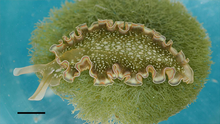Elysia clarki
| Elysia clarki | |
|---|---|

| |
| An individual of Elysia clarki on its algal food source Penicillus capitatus. Head end towards the left. The scale bar is 5 mm. | |
| Scientific classification | |
| Kingdom: | |
| Phylum: | |
| Class: | |
| (unranked): | |
| Superfamily: | |
| Family: | |
| Genus: | |
| Species: | E. clarki
|
| Binomial name | |
| Elysia clarki Pierce, Curtis, Massey, Bass, Karl & Finney, 2006[1]
| |
Elysia clarki is a species of sacoglossan sea slug, a marine gastropod mollusk in the family Plakobranchidae.
Distribution
The slug lives in the Florida Keys in near-shore.[2]
Description
Elysia clarki attains relatively large size (up to 35 mm).[2] Unlike the case for many Elysia species, which are tiny.[2]
Elysia clarki is a relatively cryptic species (has cryptic coloration).[2]
Ecology
It inhabits low wave energy habitats, such as mangrove swamps, borrow pits, and mooring canals.[2]
It feeds suctorially on several species of siphonaceous green algae including Penicillus capitatus, Penicillus lamourouxii, Halimeda incrassata, Bryopsis plumosa, and Derbesia tenissima.[2] The slug sequesters the chloroplasts from all of these species and uses them for photosynthesis.[2]

C = chloroplast,
N = cell nucleus.
Photo taken in electron microscope. Scale bar represents 3 µm.
Furthermore, Elysia clarki photosynthesizes using the stored chloroplasts for up to three months without ingesting food.[2] This species is one of the so-called "solar-powered sea slugs". Elysia clarki is an excellent organism for evaluating the relationship between kleptoplasty and feeding behavior,[2] because observations of feeding behavior and measurements of photosynthesis are possible with Elysia clarki.[2] Its photosynthetic capability (because of its kleptoplasty) has been shown to affect its foraging behavior under starvation conditions.[2] 2011 was the first time that this connection was demonstrated for any organism within the animal kingdom.[2]
See also
References
This article incorporates CC-BY-2.5 text from the reference[2]
- ^ Pierce S. K., Curtis N. E., Massey S. E., Bass A. L., Karl S. A. & Finney C. M. (2006). "A morphological and molecular comparison between Elysia crispata and a new species of kleptoplastic sacoglossan sea slug (Gastropoda: Opisthobranchia) from the Florida Keys, USA". Molluscan Research 26(1): 23-38.
- ^ a b c d e f g h i j k l m Middlebrooks M. L., Pierce S. K. & Bell S. S. (2011). "Foraging Behavior under Starvation Conditions Is Altered via Photosynthesis by the Marine Gastropod, Elysia clarki". PLoS ONE 6(7): e22162. doi:10.1371/journal.pone.0022162.
External links
- http://www.seaslugforum.net/find/elysclar
- Curtis N. E., Massey S. E. & Pierce S. K. (2006). "The symbiotic chloroplasts in the sacoglossan Elysia clarki are from several algal species". Invertebrate Biology 125: 336-345. doi:10.1111/j.1744-7410.2006.00065.x. PDF.
